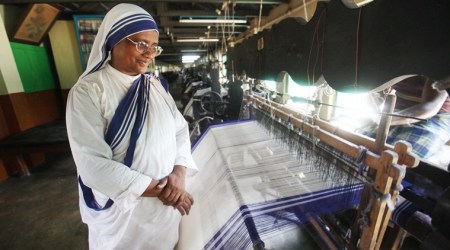 Known to be the creation of Tansen, Miyan ki Malhar was not even remotely the usual suspect among the first ragas to be taught to a novice in Hindustani classical music.
Known to be the creation of Tansen, Miyan ki Malhar was not even remotely the usual suspect among the first ragas to be taught to a novice in Hindustani classical music.
Much before I could appreciate rain in all its splendour, a lot of credit for which goes to a book — Alexander Frater’s enchanting Chasing the Monsoon — I “felt” rain for the first time in a large room in a small house. The large room I speak of was the music room in a small apartment, where Swati Roy, a practitioner of the Banaras gharana gayaki, taught all of life’s dramas through notes. I was 13 and had just been accepted as her disciple. In the years that were to follow, her improvisations in the shringar ras ragas such as Maru Bihag and Bhairavi, would make me believe in the idea of love, renditions of Maalkauns would plunge me into sadness while Bhoop would evoke what my agnostic heart felt closest to devotion. But, on this first day of my official entry into the Banaras gharana, when I had no idea how rigorous the next few years of training were going to be, my teacher began the lesson of music with Miyan ki Malhar.
Known to be the creation of Tansen, Miyan ki Malhar was not even remotely the usual suspect among the first ragas to be taught to a novice in Hindustani classical music. Most music gurus did not touch the raga for, at least, a couple of years — it was every bit as arduous to master as it was mellifluous, and, one needed to understand the nuances of music before one could appreciate its complexity. I was familiar with the basic grammar of a few ragas that my mother and my music teacher at school had taught me, but not much more. But then, Hindustani classical music is all about devotion to one’s guru and surrendering without any questions asked. So, after the first half hour of singing sa — the base note in Hindustani classical music — and merging it with the rhythmic drone of a tanpura, we moved to the aaroh and avroh of Miyan ki Malhar. Just before we began, my guru told me about the legend of Mian Tansen, who would sing the raga to please the rain gods. “Would it really rain?” I asked, dumbfounded. “The rendition was always faultless and rigorous. It always did,” she said, with confidence.
“Bijuri chamke, barse/ Meherwa, aayi badariya/ Garaj garaj mohe atahi daraave” — the bandish swirled in the air around me and hung there. I sang along, parroting every note. And, somehow, over every repetition, while I ascended and descended over the basic bandish of Miyan Malhar, a hot and humid day in June became magically transformed. With only an old fan for company and sweat trickling down my spine, rain reached the most obscure nooks of my heart. We were working with six notes when we descended, all seven in the ascent, creating various permutations and combinations that were slowly unfurling the raga’s inescapable magic in my soul.

I left my guru’s house just as dusk began to fall. My father, who’d been waiting downstairs, heard about Miyan Malhar and began telling me a story of the time when emperor Akbar, prodded by his courtiers, asked Tansen to sing raga Deepak. As the folklore went, the raga was known to light oil lamps when sung accurately. Tansen attempted the raga so fervently that the lamps got lit, but soon, the heat began to burn his body and he fell ill. A nation-wide search was launched to find someone who could please the rain gods with their recital. Two sisters, Tana and Riri, in Vadnagar in Gujarat passed the test. Tansen was taken to Vadnagar and Tana and Riri sang the raga to nurse him back to health. But, when Akbar summoned the sisters to sing in his court, the two committed suicide as they had vowed to sing only in front of their family deity. Vadnagar still holds an annual classical music festival known as the Tana and Riri festival.
It would be many more years before I would discover Pakistani singer Ustad Salamat Ali Khan’s rendition of the same raga in Satyajit Ray’s Jalsaghar. One of the torchbearers of the Sham Chaurasi gharana, Khan sang a different bandish in the same raga, Garjat boondan barse. Pandit Jasraj’s rendition of the same bandish — Ab ke baras tohe jaane na doongi, Sada rangeele Mohammad Shah — gives the piece the turns and twists of the Mewati gharana. The same popular bandish was rendered by Kishori Amonkar. Vani Jairam’s timeless rendition of Bole re papihara in Jaya Bachchan’s debut film, Guddi, is yet another favourite of mine. I heard every word, every note, like they were my heart’s tales. It even made a poet out of me for a while. Then, there is a surreal Ustad Vilayat Khan performance of Miyan Malhar, which took place in Chicago in 1980 — live performances of that calibre are hard acts to come by. But, the one composition that takes my breath away is Suresh Wadekar’s Badal ghumad bhar aaye in Zakir Hussain’s Saaz. Composed by Yashwant Dev, it has got to be Wadekar’s most underrated rendition, and one of his finest. Every time I play it, it reminds me of the stories I heard of the raga as a child.
Somewhere in the middle of the story my father was telling me, I began to notice that the sky was turning dark and it was not just because of dusk. By the time we reached home, there was rain and the sound of distant thunder. I distinctly remember the rush of the wind that made the jamun tree across our balcony break into a joyful dance. I sat down on a chair and began humming Miyan Malhar to the sound of incessant patter. And there it was — solace, and satisfaction, and, the kind of happiness that only music can provide.
Which is why, when I meet people who say that they aren’t into music, I tell them of Miyan Malhar and the magic it can bring to people’s lives. I tell them of the 13-year-old and her wonderful discovery of rain. For, if you bring Miyan Malhar to life, monsoon is all yours.

